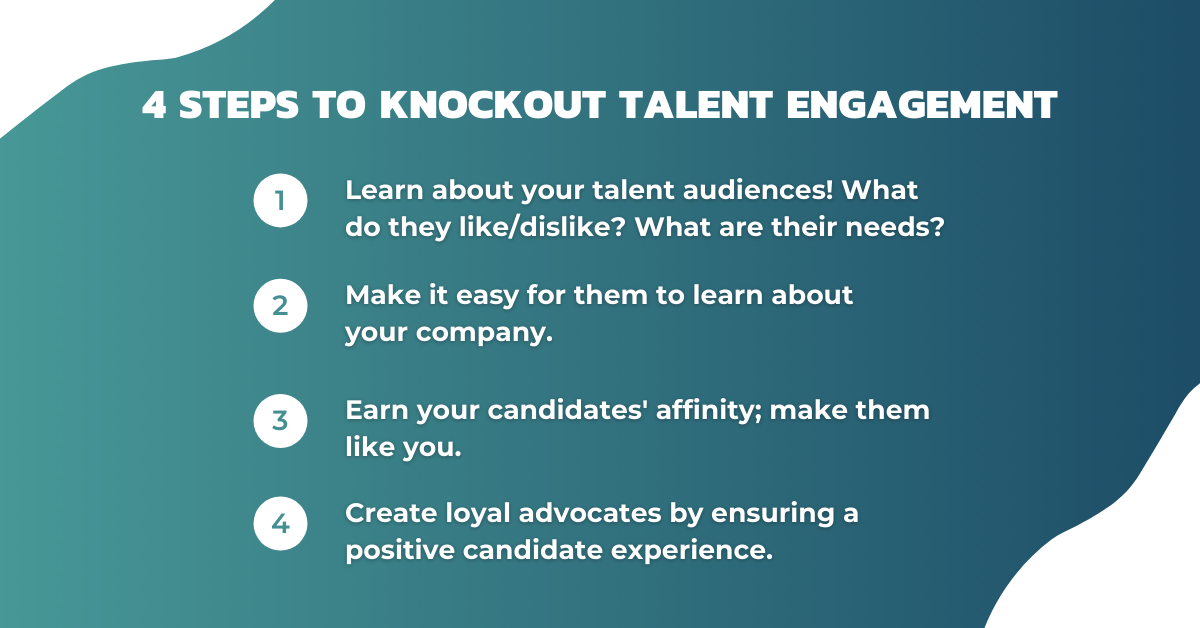This article on talent engagement and strategies for winning over top talent was originally published in August 2020. All relevant copy and statistics have been updated as of October 2021.
Knockout Talent Engagement doesn’t just happen. Talent leaders have to be intentional about creating an engagement strategy based on business improvement, individual employee needs, and desired productivity.
What Is A Proper Talent Engagement Strategy, And How Does One Make It “Knockout”?
Simply put, a Talent Engagement strategy is focused on building relationships with candidates by interacting with them in a meaningful and personalized way. It’s a crucial part of Talent Management in general, which is the full set of HR processes to attract, onboard, develop, engage, and retain talent. The reason it’s so important to create an amazing Talent Engagement strategy is it needs to be strong enough to carry on into the employees’ lifecycle with the company. And, it starts with you.
When was the last time your team conducted a #talentengagement audit? It’s one of the first steps to boosting your #TAStrategy. @TalentTechLabs details how you can evaluate your current processes: Click To TweetA great Talent Management strategy improves business performance. We know productive employees who are engaged increase the bottom line, and that engaged candidates often turn into engaged employees, overall strengthening their place of work.
Four Steps To Knockout Talent Engagement
Okay, we know why it’s important, but how do we start? Engaging top talent is much simpler than you might think (but that doesn’t mean it’s easy.)

In the end, you’ll have advocates who can speak to your employer brand, allowing candidates to be more engaged and employees to support your Talent Acquisition pipeline.
Both corporations and staffing agencies must invest in talent engagement early on to create a significant competitive advantage. A solid plan to engage talent and a clear directive to carry it out are worth its weight in gold when the talent market gets tight or when recruiting in a competitive industry or region.
Creating A Strategy That Makes Sense For You
Attracting and engaging candidates is virtually synonymous with recruitment marketing. This is where your marketing team can assist! Take your cues from their actions when bringing in customers and clients on the other side of the business.
Set Up An Engagement Audit
- Check open rates and click-through rates on your emails to talent.
- Who is opening your emails?
- What are they clicking on?
- Do you have a candidate relationship management system (CRM) in place? If so, ask yourself:
- How quickly does your TA team get back to candidates?
- Are questions answered promptly?
- How much follow-up information is given post-application? Post-interview? Post-offer?
- What does your team do with disengaged candidates?
- Where is your career page or site?
- Is it available through the main navigation?
- Does it appear in the footer?
- Are there Call-to-Actions (CTAs) throughout the site?
- Check Google Analytics for Time On-Page and Sessions Per User on your Careers Page
- How easy is it to access your open positions?
- Do your open positions appear ONLY on job boards or your own page?
- Do you have an internal referral program?
- Do you offer any referral benefits?
- Does your career site offer cultural information about your company or give candidates a view into teams, leadership, and what it’s like to work at your company?
- Are benefits easy to find?
- Is compensation transparent?
- Do you offer a mission or impact statement for open positions or simply a list of responsibilities?
- Check your social accounts. Ask yourself:
- What are potential candidates ‘liking,’ commenting on, or sharing?
- Are current employees and talent pros in your organization interacting with social comments or engaging?
- If your company has a social feed for careers, is it a list of job updates, or does it include holistic information about working at your company?
Define Your Personas
While it’s not wise to build a persona for every open position, it is useful to understand the kinds of personas for your job families or for positions you frequently have open. Personas go beyond simple demographic information and into strategic stories you tell about the people who work for you and the people you WANT to work for you.
If you know your audience, you’ll know what will appeal and resonate with them.
Identifying your audiences’ likes, dislikes, education levels, media usage, benefit preferences, and social causes will help you hone in on what to highlight in your job postings and advertisements, along with which channels to use to reach out to them and initiate conversation.
Ask yourself:
- What media do they spend their time on?
- Where can you reach them? (Text message? Social media? LinkedIn?)
Remember: See where your most recent hires are looking online to get an idea. Your ideal talent is likely already looking in the same place.
Tech Stack Rules
Many TA pros ignore the tech stack until they have a pain point. This is all backward.
Your tech stack should be one of your first considerations when it comes to building any strategy. Building and continually innovating your tech stack is not an easy feat, but it is essential for a robust talent engagement strategy. It is often difficult to pinpoint the right technology for your unique business needs and to keep up with the ever-changing technology landscape. The process of selecting and implementing new technology can be daunting and overwhelming, especially if you’re trying to hire in high-volume.
Most organizations will already have an ATS or CRM. However, the ATS is primarily an organizational tool. It should be used to enable engagement programs and strategies, while the CRM facilitates and drives the interactions between candidates, recruiters, and hiring managers. Many ATS providers understand this gap and are actively implementing CRM capabilities into their platforms, but by and large, the ATS serves to track applicants as the name implies.
If you’re lucky to have both (bonus points for your employee referral program or employee advocacy platform) use the data you pull from there to supplement your audit. Many of these programs have robust analytics capabilities, which can help identify bottlenecks and holes in your talent engagement strategies and team.
Bonus Material: A winning talent engagement and acquisition strategy is one that relies on advanced, insightful tools. See why TA professionals are embracing the use of Talent Intelligence tools to help them achieve their recruitment and hiring goals.
The More You Know
Now that you know what you’re putting out in front of your candidates and what they are looking for every day, you can align your engagement efforts with how your preferred candidates communicate.
Perhaps you’ve been running long, detailed ads on LinkedIn, but your candidates prefer an online event with SMS updates about open roles. You may have a host of interested applicants pinging your team on social but no engagement or notification system to leverage it. Perhaps your ATS is a black hole that frustrates and irritates your target talent pipeline and needs to be upgraded. Whatever the hurdle, understanding how your candidates communicate daily is the foundation for creating a Knockout Talent Engagement Strategy.
Don’t know which tech to pick to make your Talent Engagement strategy sing? TTL memberships offer technology ratings, insider-only demo days, and analyst hours to make the decision easier than ever to make and implement. Learn more here.

